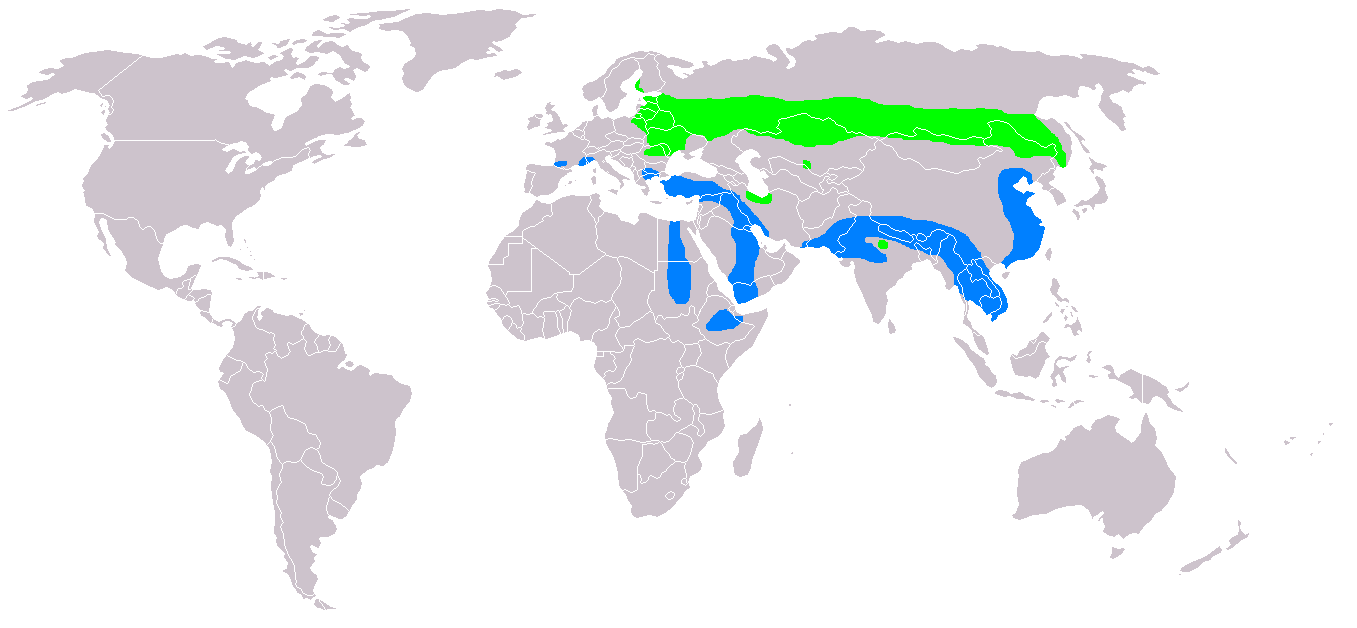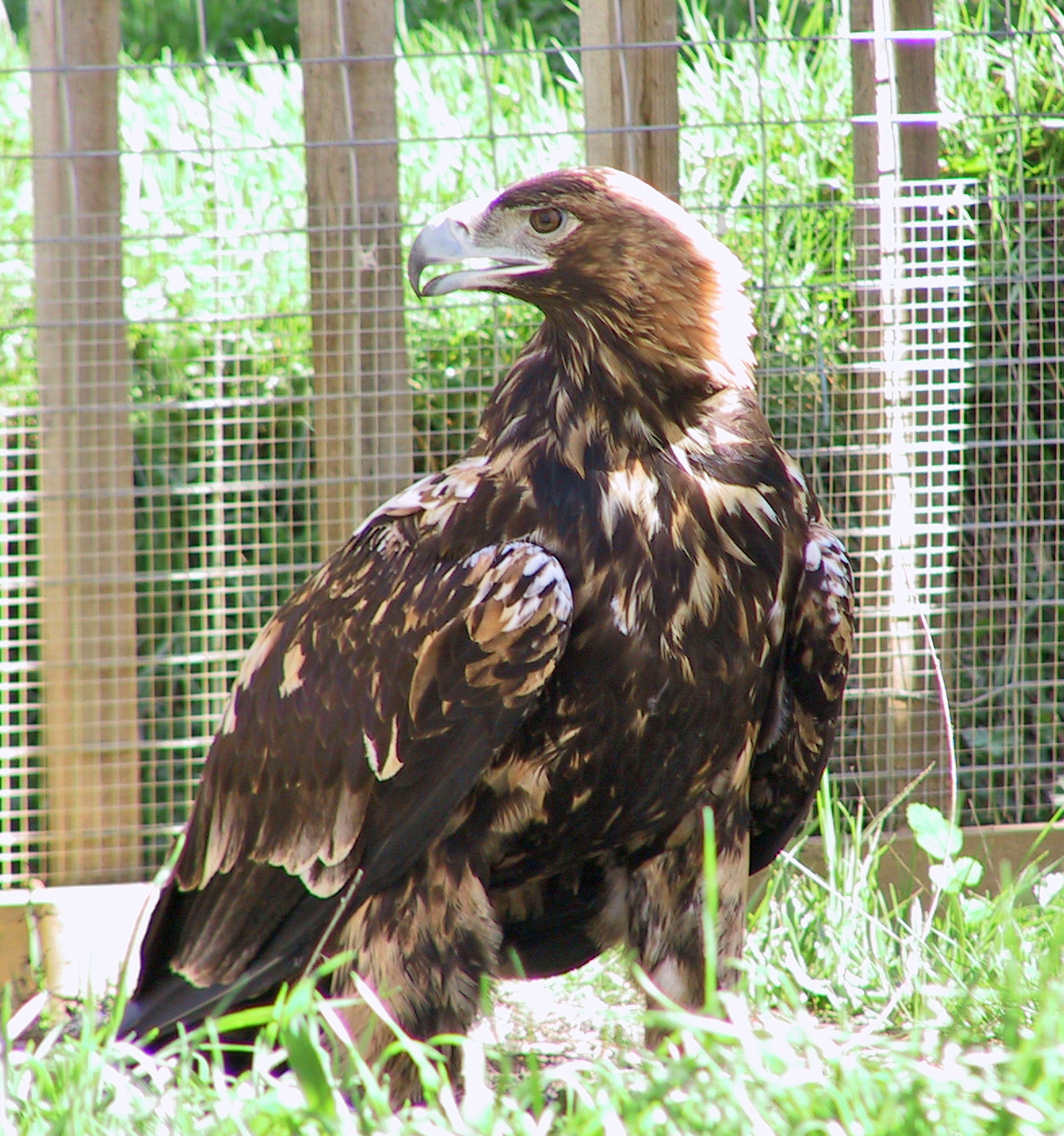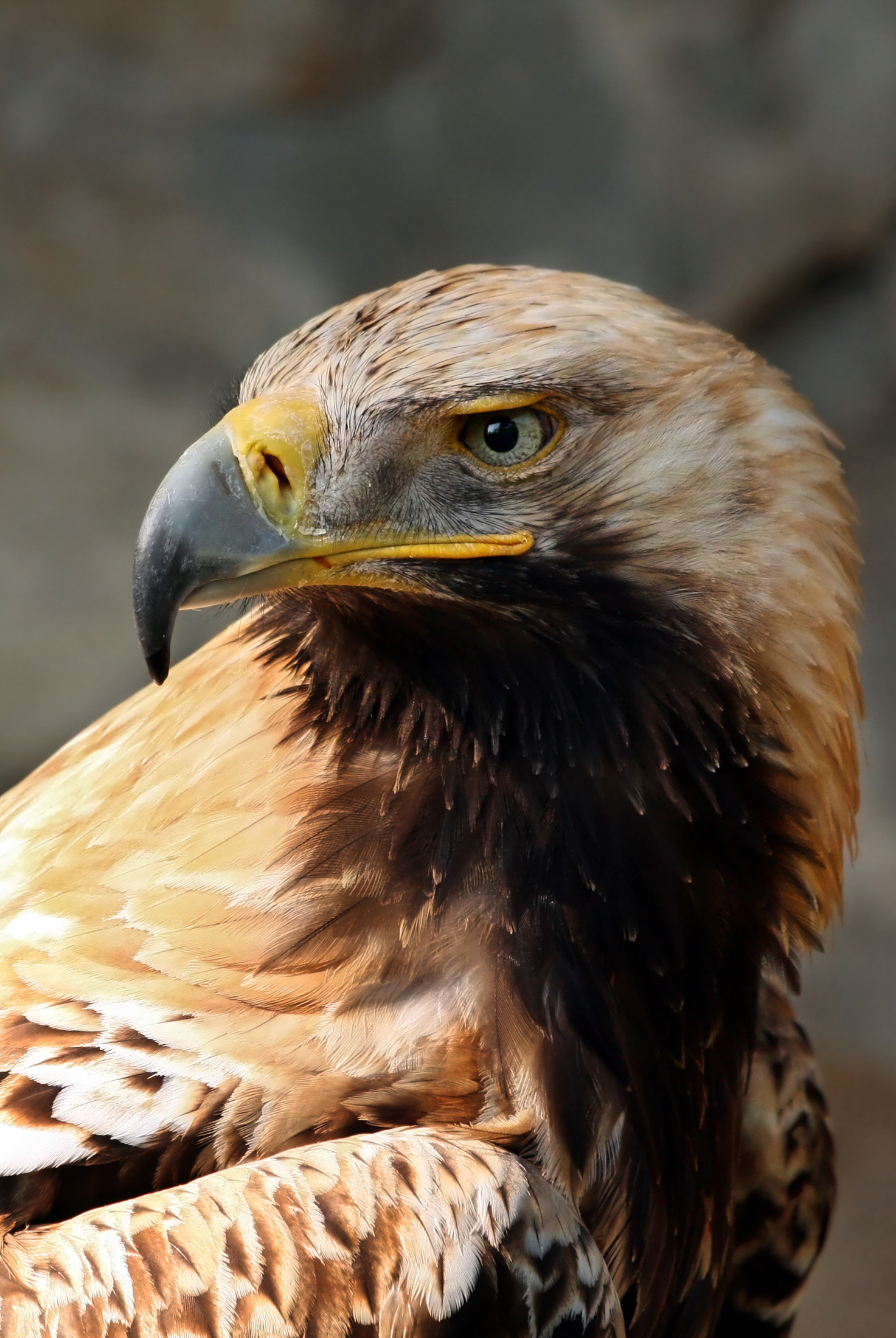|
Booted Eagles (group)
Booted eagles are eagles that have fully feathered tarsi. That is, their legs are covered with feathers down to the feet. Most other accipitrids have bare lower legs, scaled rather than feathered. They may be treated as an informal group, as distinct from "fish eagles" (or "sea eagles"), "snake eagles", and "giant forest eagles". They may also be treated as a formal taxon, either as a tribe (Aquililae) or subfamily (Aquilinae). The booted eagles, sea eagles, harpy eagles and buteonine hawks are heavily built birds that have traditionally been classified together in the large subfamily Buteoninae. In 2005, Heather Lerner and David Mindell proposed separating the eagles into their own subfamilies Aquilinae, Haliaeetinae, and Harpiinae, leaving only the buteo–buteogallus clade in a more restricted Buteoninae. Included in the booted eagles are the genera ''Aquila'', ''Hieraaetus'' and ''Clanga''; all species described as "hawk eagles" including the genera ''Spizaetus'' and ' ... [...More Info...] [...Related Items...] OR: [Wikipedia] [Google] [Baidu] |
Eagle
Eagle is the common name for many large birds of prey of the family Accipitridae. Eagles belong to several groups of genera, some of which are closely related. Most of the 68 species of eagle are from Eurasia and Africa. Outside this area, just 14 species can be found—2 in North America, 9 in Central and South America, and 3 in Australia. Eagles are not a natural group but denote essentially any kind of bird of prey large enough to hunt sizeable (about 50 cm long or more overall) vertebrates. Description Eagles are large, powerfully-built birds of prey, with heavy heads and beaks. Even the smallest eagles, such as the booted eagle (''Aquila pennata''), which is comparable in size to a common buzzard (''Buteo buteo'') or red-tailed hawk (''B. jamaicensis''), have relatively longer and more evenly broad wings, and more direct, faster flight – despite the reduced size of aerodynamic feathers. Most eagles are larger than any other raptors apart from some vultures. The smalles ... [...More Info...] [...Related Items...] OR: [Wikipedia] [Google] [Baidu] |
Verreaux's Eagle
Verreaux's eagle (''Aquila verreauxii'') is a large, mostly African, bird of prey. It is also called the black eagle, especially in southern Africa, not to be confused with the Indian black eagle (''Ictinaetus malayensis''), which lives far to the east in Asia. It lives in hilly and mountainous regions of southern and eastern Africa (extending marginally into Chad), and very locally in West Africa, the Arabian Peninsula and the southern Middle East. Verreaux's eagle is one of the most specialized species of accipitrid in the world, with its distribution and life history revolving around its favorite prey species, the rock hyraxes. When hyrax populations decline, the species have been shown to survive with mixed success on other prey, such as small antelopes, gamebirds, hares, monkeys and other assorted vertebrates. Despite a high degree of specialization, Verreaux's eagle has, from a conservation standpoint, been faring relatively well in historic times. One population of t ... [...More Info...] [...Related Items...] OR: [Wikipedia] [Google] [Baidu] |
Hieraaetus
The genus ''Hieraaetus'', sometimes known as small eagles or hawk-eagles, denotes a group of smallish eagles usually placed in the accipitrid subfamilies Buteoninae or Aquilinae. They are medium-sized birds of prey inhabiting Europe, Asia, Africa, New Guinea and Australia. A recently-extinct species, the New Zealand Haast's eagle, was the largest eagle ever known, weighing up to , with a wingspan. Taxonomy and species The genus ''Hieraaetus'' was introduced in 1844 by the German naturalist Johann Jakob Kaup with the booted eagle as the type species. The name combines the Ancient Greek ''hierax'' meaning "hawk" with ''aetos'' meaning "eagle". Molecular genetic research has found ''Hieraaetus'' to be polyphyletic with '' Aquila''. ''Hieraaetus kienerii'' was found to be most distinct, and has been assigned to a separate genus, '' Lophotriorchis''. [...More Info...] [...Related Items...] OR: [Wikipedia] [Google] [Baidu] |
Clanga (genus)
''Clanga'' is a genus which contains the spotted eagles. The genus name is from Ancient Greek Ancient Greek includes the forms of the Greek language used in ancient Greece and the ancient world from around 1500 BC to 300 BC. It is often roughly divided into the following periods: Mycenaean Greek (), Dark Ages (), the Archaic pe ... ''klangos'', "eagle". Species Notes References {{Taxonbar, from=Q9160388 Bird genera Birds of prey of Eurasia ... [...More Info...] [...Related Items...] OR: [Wikipedia] [Google] [Baidu] |
Greater Spotted Eagle
The greater spotted eagle (''Clanga clanga''), occasionally called the spotted eagle, is a large bird of prey. Like all typical eagles, it belongs to the family Accipitridae. Its feathered legs indicate it is a member of the subfamily Aquilinae, also known as the "booted eagles".Helbig, A. J., Kocum, A., Seibold, I., & Braun, M. J. (2005). ''A multi-gene phylogeny of aquiline eagles (Aves: Accipitriformes) reveals extensive paraphyly at the genus level''. Molecular phylogenetics and evolution, 35(1), 147-164. This species was once thought to be included in the genus '' Aquila'' but now belongs to a distinct genus, '' Clanga'', along with the other two species of spotted eagles.Helbig, A. J., Seibold, I., Kocum, A., Liebers, D., Irwin, J., Bergmanis, U., Meyburg, B.-U., Scheller, W., Stubbe, M. & Bensch, S. (2005). ''Genetic differentiation and hybridization between greater and lesser spotted eagles (Accipitriformes: Aquila clanga, A. pomarina)''. The Journal of Ornithology, 146(3 ... [...More Info...] [...Related Items...] OR: [Wikipedia] [Google] [Baidu] |
Indian Spotted Eagle
The Indian spotted eagle (''Clanga hastata'') is a large bird of prey native to South Asia. Like all typical eagles, it belongs to the family Accipitridae. The typical eagles are often united with the buteos, sea eagles and other more heavyset Accipitridae, but more recently it appears as if they are less distinct from the more slender accipitrine hawks. Description The Indian spotted eagle is about 60 cm in length and has a wingspan of 150 cm. It is broad-headed, with the widest mouth of all spotted eagles.Parry, S.J., Clark, W.S., Prakash, V. (2002) On the taxonomic status of the Indian Spotted Eagle ''Aquila hastata''. Ibis Volume 144 Issue 4: 665 - 675 This species has a lighter coloration overall compared to its relatives, with a darker iris that makes the eyes appear darker than the plumage (rather than the other way around as in the northern spotted eagles). Adults can be told apart from the greater spotted eagle by its lighter color, darker eyes, and habitat pr ... [...More Info...] [...Related Items...] OR: [Wikipedia] [Google] [Baidu] |
Lesser Spotted Eagle
The lesser spotted eagle (''Clanga pomarina'') is a large Eastern European bird of prey. Like all typical eagles, it belongs to the family Accipitridae. The typical eagles are often united with the buteos, sea eagles, and other more heavy-set Accipitridae, but more recently it appears as if they are less distinct from the more slender accipitrine hawks than believed. Description This is a medium-sized eagle, about in length and with a wingspan of . Its head and wing coverts are pale brown and contrast with the generally dark plumage. The head and bill are small for an eagle. Usually, a white patch occurs on the upper wings, and even adults retain a clearly marked white "V" on the rump; the wing markings are absent and the white "V" is not well-defined in the greater spotted eagle. The juvenile has less contrast in the wings, but the remiges bear prominent white spots. It differs from greater spotted eagle juveniles by a lack of wing covert spotting and the presence of a cream ... [...More Info...] [...Related Items...] OR: [Wikipedia] [Google] [Baidu] |
Steppe Eagle
The steppe eagle (''Aquila nipalensis'') is a large bird of prey. Like all eagles, it belongs to the family Accipitridae. The steppe eagle's well-feathered legs illustrate it to be a member of the subfamily Aquilinae, also known as the "booted eagles".Helbig, A. J., Kocum, A., Seibold, I., & Braun, M. J. (2005). ''A multi-gene phylogeny of aquiline eagles (Aves: Accipitriformes) reveals extensive paraphyly at the genus level''. Molecular phylogenetics and evolution, 35(1), 147–164. This species was once considered to be closely related to the bird migration, sedentary tawny eagle (''Aquila rapax'') and the two forms have previously been treated as Biological specificity, conspecific. They were split based on pronounced differences in morphology and anatomy; two molecular studies, each based on a very small number of genes, indicate that the species are distinct but disagree over how closely related they are. The steppe eagle is in many ways a peculiar species of eagle. It is a ... [...More Info...] [...Related Items...] OR: [Wikipedia] [Google] [Baidu] |
Tawny Eagle
The tawny eagle (''Aquila rapax'') is a large bird of prey. Like all eagles, it belongs to the family ''Accipitridae''. Its heavily feathered legs mark it as a member of the subfamily Aquilinae, also known as booted eagles.Helbig, A. J., Kocum, A., Seibold, I., & Braun, M. J. (2005). ''A multi-gene phylogeny of aquiline eagles (Aves: Accipitriformes) reveals extensive paraphyly at the genus level''. Molecular phylogenetics and evolution, 35(1), 147-164. Tawny eagles have an extensive but discontinuous breeding range that constitutes much of the African continent as well as the Indian subcontinent, with rare residency in the southern Middle East. Throughout its range, it favours open dry habitats such as semideserts, deserts steppes, or savanna plains. Despite its preference for arid areas, the species seldom occurs in areas where trees are entirely absent.Hustler, K., & Howells, W. W. (1989). ''Habitat preference, breeding success and the effect of primary productivity on Tawny E ... [...More Info...] [...Related Items...] OR: [Wikipedia] [Google] [Baidu] |
Spanish Imperial Eagle
The Spanish imperial eagle (''Aquila adalberti''), also known as the Spanish eagle or Adalbert's eagle, is a species of eagle native to the Iberian Peninsula. The binomial commemorates Prince Adalbert of Bavaria. Due to its distinct “epaulettes”, old literature often referred to this species as the white-shouldered eagle. Formerly, the Iberian imperial eagle was considered to be a subspecies of the eastern imperial eagle, but is now widely recognised as a separate species due to differences in morphology, ecology, and molecular characteristics. Description This is a large raptor and quite large eagle, broadly similar in size to its cousin, the eastern imperial eagle, which is found in a considerably different distributional range. Compared to sympatric largish booted eagles, it is somewhat smaller than the golden eagle and somewhat larger than the Bonelli's eagle. Spanish imperial eagle can weigh from . The average weight of males in a sample of 10 was while that of ... [...More Info...] [...Related Items...] OR: [Wikipedia] [Google] [Baidu] |
Eastern Imperial Eagle
The eastern imperial eagle (''Aquila heliaca'') is a large bird of prey that breeds in southeastern Europe and extensively through West and Central Asia. Most populations are migratory and winter in northeastern Africa, the Middle East and South and East Asia. Like all eagles, the eastern imperial eagle is a member of the family Accipitridae. Furthermore, its well feathered legs mark it as a member of the subfamily Aquilinae. It is a large, dark-colored eagle, with a resemblance to other members of the genus '' Aquila'' but it is usually the darkest species in its range.Forsman, D. (1999). ''The raptors of Europe and the Middle East: a handbook of field identification''. London: T & AD Poyser. This is an opportunistic predator that mostly selects smallish mammals as prey but also a fairly large proportion of birds, reptile and other prey types, including carrion. Compared to other ''Aquila'' eagles, it has a strong preference for the interface of tall woods with plains and other op ... [...More Info...] [...Related Items...] OR: [Wikipedia] [Google] [Baidu] |
African Hawk-eagle
The African hawk-eagle (''Aquila spilogaster'') is a large bird of prey. Like all eagles, it belongs to the family ''Accipitridae''. This species’ feathered legs mark it as a member of the Aquilinae subfamily.Lerner, H., Christidis, L., Gamauf, A., Griffiths, C., Haring, E., Huddleston, C.J., Kabra, S., Kocum, A., Krosby, M., Kvaloy, K., Mindell, D., Rasmussen, P., Rov, N., Wadleigh, R., Wink, M. & Gjershaug, J.O. (2017). ''Phylogeny and new taxonomy of the Booted Eagles (Accipitriformes: Aquilinae)''. Zootaxa, 4216(4), 301-320. The African hawk-eagle breeds in tropical Sub-Saharan Africa. It is a bird of assorted woodland, including both savanna and hilly areas but the tend to occur in woodland that is typically dry. The species tends to be rare in areas where their preferred habitat type is absent. This species builds a stick nest of around across in a large tree. The clutch is generally one or two eggs. The African hawk-eagle is powerfully built and hunts small to medium s ... [...More Info...] [...Related Items...] OR: [Wikipedia] [Google] [Baidu] |




.jpg)





.jpg)